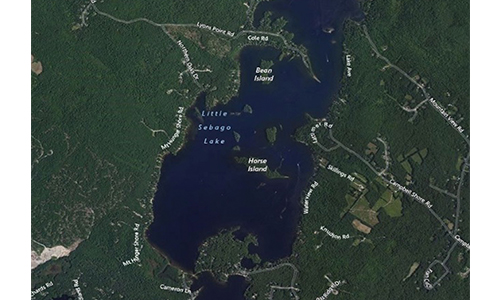LITTLE SEBAGO LAKE

Little Sebago stretches for approximately 5-1/2 miles from end to end and is just over 1 mile at its widest point. Little Sebago encompasses roughly 1,898 acres of crystal clear water dotted with an assortment of shallow rocky humps and numerous islands scattered throughout. The maximum depth of the lake is 52 feet with an average of 16 feet.
Little Sebago supports a trophy bass fishery to go along with its excellent trout fishing. It is regularly stocked with brown trout and occasional rainbows. Some local anglers even reported landing a rare brook trout or two over the years. Little Sebago is one of the premier bass fisheries in southern Maine. Resident largemouth and smallmouth bass enjoy ample forage in the form of yellow perch, white perch, sunfish, shiners and a variety of small minnow species. The lake also supports chain pickerel and hornpout.
Common techniques used for ice fishing Little Sebago are fairly simple. Begin by identifying areas where structure combines with well-oxygenated water to provide safety and forage for large predator fish species. If available, use a portable fish/depth finder or flasher and a pond map, and then adjust depths and locations based on your results. Some of the better areas to target include the numerous rocky humps and tiny islands situated near sharp changes in depth. Other productive areas include small, shallow bays, inlets, and coves, which provide shelter from cutting winds prominently blowing across the main body of the lake. The best technique for catching trophy bass in Little Sebago includes the use of live bait (shiners, smelts, etc.) and running a full spread of tip-ups, working the bottom from shallow water (5 to 10 feet) out to the deeper areas of 25 feet or more. When targeting large, lunker-size fish, try setting tip-ups with medium or large size baits near the bottom in deep water and near drop-offs. Then set a few more at varying depths in shallow water closer to shore, rigged with lighter leaders and smaller bait, (which double as potential trout holes). For best results be sure to stay active, drilling additional holes and moving tip-ups that are not producing.
The best method for catching perch, brown trout and rainbows is active jigging, utilizing small shiny spoons such as the Kastmaster, Al’s Goldfish, and the trusty ole Swedish Pimple topped off with a mealworm or small strip of cut baitfish. You can start by jigging close to the bottom in shallow water from 10 to 15 feet in depth and work your way out from there, adjusting based on results. Brown trout can sometimes be finicky and hard to pinpoint under the ice, so locating them may take a little more effort on the angler’s part. Schooling species such as white and yellow perch can save a slow day and make for excellent fare at the dinner table.
Public access for Little Sebago is available via a well-maintained boat ramp located on the southwest corner of the lake. Follow Route 302 north to North Windham, take a right on Anglers Road and follow it to the water’s edge (The access road will turn into Woodland Road and Mt Hunger Shore Road.). General fishing regulations are in effect throughout the year and can be reviewed on the Maine IF&W website at: http://www.maine.gov/ifw. Some years a hard freeze will produce enough solid ice to safely drive a vehicle onto the ice—which is very convenient on those frigid winter days with sub-zero wind chills. Otherwise a snow machine is very handy for exploring far reaching areas of the pond.
